Alpine Climbing: How to Start (Gear Guide 2024)

Published on: 10/02/2023
For many climbers, alpine climbing is the crown jewel of all climbing disciplines. It requires a culmination of different climbing skills and experiences and reflects a climber’s true mastery over the sport.
But what really is alpine climbing? What does it entail? And how does one get started?
In the following article, we will discuss a brief history of the sport of alpinism and then transition into a review of modern alpinism. Aftward, we will provide recommendations for how to start, including what gear to bring.
What’s Alpine Climbing?
Alpine climbing, also known as alpinism, is defined as climbing anywhere in an alpine environment. In other words, at high elevation and above treeline.
It can include bouldering and sport climbing at high elevations, for example, Upper Chaos Canyon (1) in Rocky Mountain National Park, Colorado.
However, alpine climbing is most notably associated with long multi-pitch rock, ice, or mixed routes on massive mountains or prominent rock formations in alpine landscapes, which is very similar, if not the same, as mountaineering. For example, the Bugaboos in British Columbia, Canada.
Alpine climbing is a multi-disciplinary sport. Therefore, an alpine climber must blend together myriad skills to successfully climb their chosen objective. For example, for many objectives in alpine terrain, climbers must be able to climb on rock, ice, and snow, hike long distances with hefty packs, and navigate glaciated and avalanche-prone terrain.
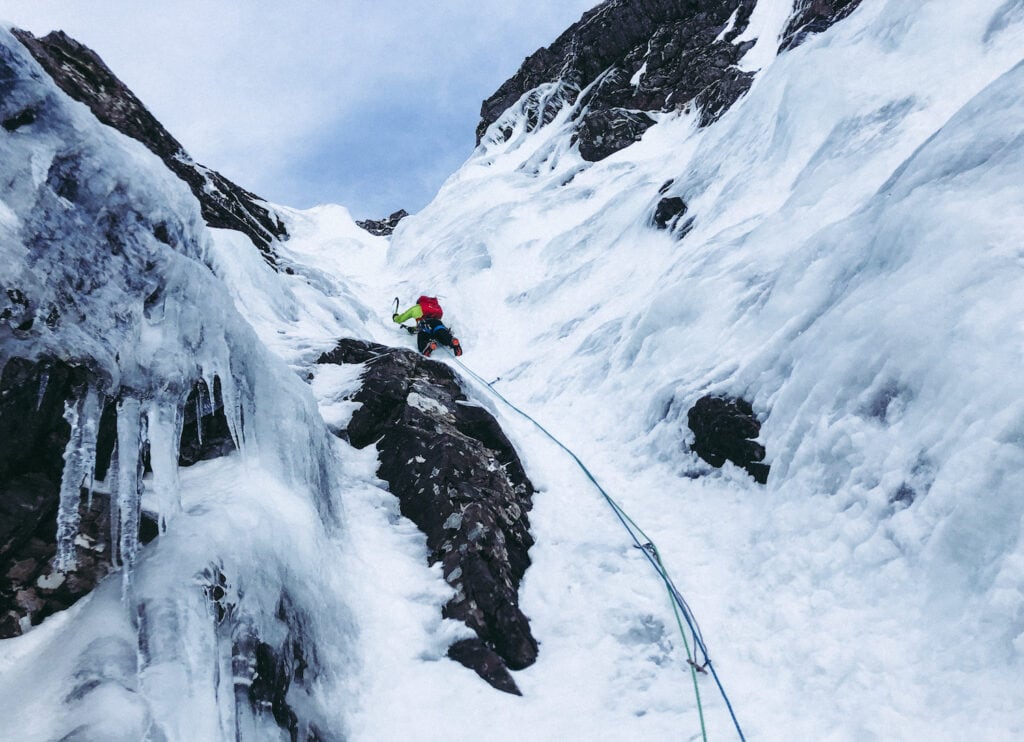
Rock Climbing in Alpine Terrain
Alpine climbing objectives often involve rock climbing. Depending on the climbing route, alpine climbers have to be versed in placing traditional climbing protection such as camalots, nuts, hexes, and pitons. Occasionally climbers may clip bolts. However, alpine routes are rarely considered pure sport climbs.
Many alpine rock routes can be climbed in a single day. However, if the objective is large enough, alpine rock climbing may require big wall climbing tactics and skills.
Big wall climbing is a type of multi-pitch rock climbing where the rope team may spend multiple days on the wall, bringing extra equipment and utilizing special skills to haul the gear up the climb.
Ice and Mixed Climbing in Alpine Terrain
In high enough elevations and specific alpine environments around the globe, alpine climbing may require ice and mixed climbing. Therefore, climbers must be versed in how to swing an ice axe, use crampons, place protection with ice screws and pickets, navigate glaciated terrain, and perform crevasse rescues.
For many alpinists, the epitome of an alpine climb involves moving through snowy and glaciated terrain deep into the wilderness to approach a route that requires a wide breadth of climbing expertise from rock and ice climbing disciplines to safely and successfully summit the mountain.
A Brief History of Alpinism
Nowadays, alpine climbing refers to any type of climbing at high elevations and in alpine landscapes. It doesn’t matter if you are in Argentinian Patagonia climbing Cerro Torre (2) or attempting the Diamond (3) on the East face of Long’s Peak.
However, it wasn’t always that way. During the golden age of alpinism, the sport of alpine climbing was primarily evolving in a specific mountain range in Europe- the Alps.
Most alpinists with a knack for the history of their beloved sport would agree that the golden age of alpine climbing (4) in the alps occurred between 1854 and 1865.
In 1854, Alfred Wills made the first ascent of the Wetterhorn in the Swiss Alps. And in 1865, Edward Whymper summited the Matterhorn, also in the Swiss Alps. Between these two iconic achievements, other feats of world-class alpine climbing were occurring in other places.
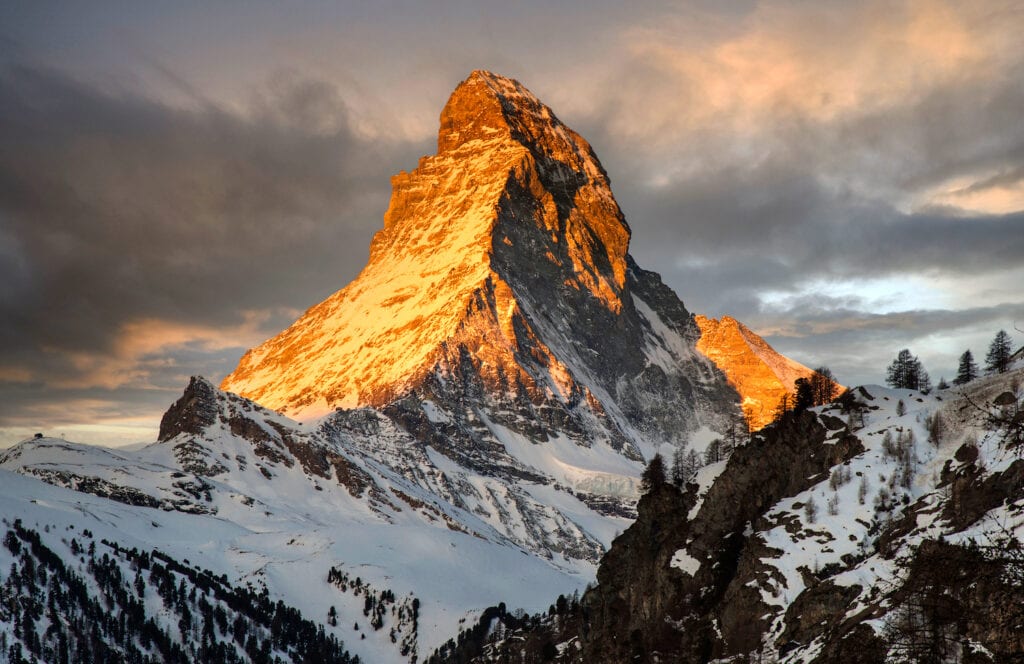
Other Notable Ascents in the Alps (only to name a few)
- 1855- Mont Blanc du Tacul was climbed for the first time in the French Alps
- 1858- the west face of the Eiger is summited
- 1860- Gran Paradiso in the Italian alps is successfully climbed
- 1861- the Weisshorn is climbed in the Pennine Alps
- 1864- Aiguille de Tré la Tête
- 1864- the tallest mountain in the Italian alps, Marmolada, is summited
The Ethics of Modern Alpinism
A lot has changed since the glory days of the Golden Age of Alpinism. Back then, a three-person rope team (and sometimes more) targeted the path of least resistance up the mountain. They wore heavy leather boots and wool clothing and donned homemade crampons, ice axes, and climbing protection.
Back in the day, old-school climbers would suffer for days, often limited not by their climbing ability or bravery but by bad weather and a lack of the right equipment. Nonetheless, they often persevered, even in the most unthinkable conditions.
Since then, the ethics of modern alpinism have changed drastically, especially within the upper echelons of the sport. Athletes have gotten stronger, the equipment has improved, and alpine climbs have continually gotten harder.
Now, alpine ascents are taking place throughout the entire globe. Modern alpinists continually push the envelope with mind-numbing fast ascents of classic routes and multi-objective linkups.
Despite the difficulty of routes, modern alpinists continue to climb faster and lighter. Now, it’s common to attack massive technical routes in a two-person rope team. Some of the best, such as Marc-André Leclerc (1992-2018), even cast off solo without a second climber and a hyperlight alpine rack to save weight.
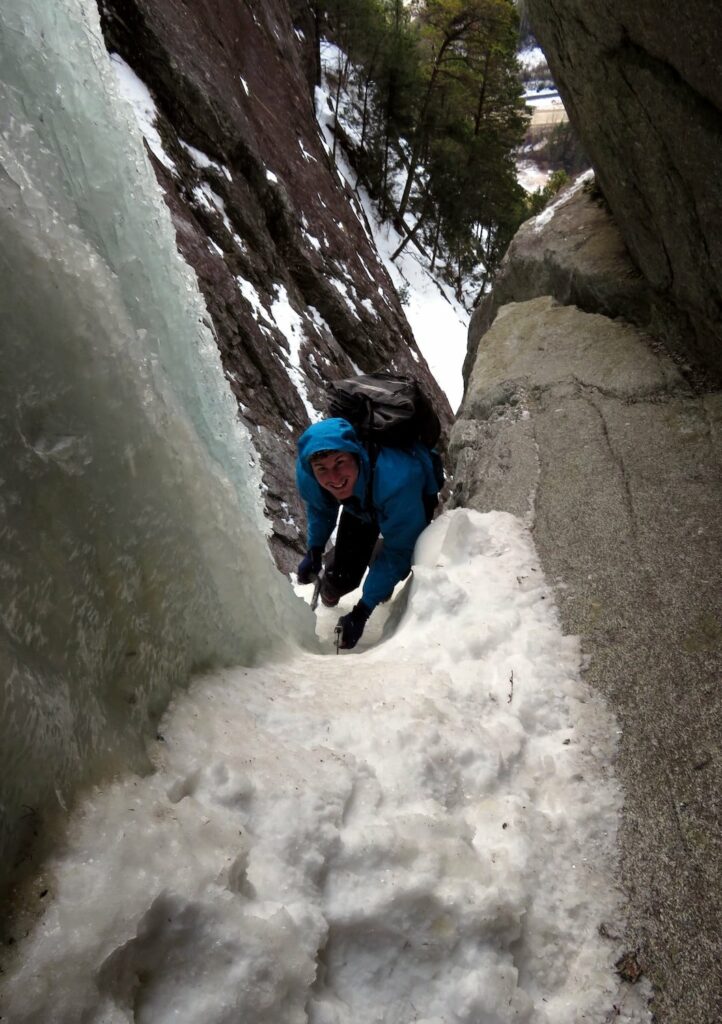
Another impressive solo accomplishment was the Fitz Traverse (5), completed in 2021 by professional climber Sean Villanueva O-Driscoll.
For many objectives, “light and fast” is the ethic. Modern alpinism and mountaineering are all about reaching the summit in a day. For specific routes and longer alpine climbs, spending a day or two to climb is acceptable, but even then, the climbers bring only the most lightweight and limited selection of climbing gear, other equipment, food, and water.
The “Amateur Alpinism” Climbing Culture
Modern alpine climbing has come a long way since the golden age of alpinism. The sport has evolved beyond the European Alps.
But pro climbers aren’t the only ones attempting alpine routes. Other climbers like you and I also enjoy bagging summits and alpine tours in breathtaking mountain landscapes.
The modern climbing community is full of amateur, or hobby climbers, who love the sport and who love scaling big objectives in the alpine. Amateur alpinism is fueled by strong climbers with day jobs and a climbing culture that is built upon self-exploration and mentoring new generations of climbers.
This type of amateur alpinism is an incredible way to explore remote regions and experience the solitude that only alpine meadows and wind-blasted peaks can offer. But it should not be taken lightly.
Any climber interested in alpine climbing must understand that although the sport is wonderfully exhilarating, it also comes with certain dangers and hours (sometimes multiple days) of suffering and hard work.
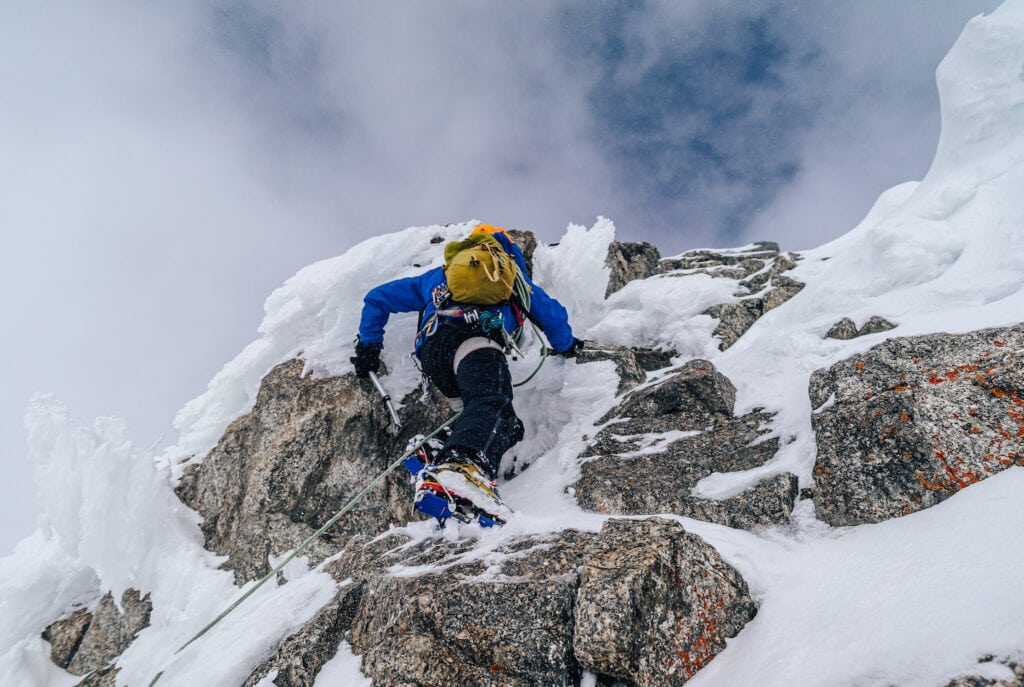
Risks Associated With Alpine Climbing
All forms of climbing are inherently dangerous. However, alpine climbing is notorious for being dangerous. The deeper you go into the wilderness and the larger your climbing objectives become, the more risk you expose yourself to.
Understanding the risks associated with alpine climbing is the first step in getting ready to venture into the backcountry on the approach to your first alpine climb.
High elevation and inclement weather
The altitude is a constant obstacle. At particularly high altitudes, mountain sickness is common. More secure altitude-related disorders like high altitude cerebral edema are also a constant threat.
Weather changes quickly at altitude. Bad weather can expose you to wind, snow, and rain, which may lead to hypothermia or other cold-related injuries.
Falling rocks and icefall
Alpine rock offers incredible climbing, but sections of climbs can also be notoriously loose and unsafe due to freeze-thaw cycles at high elevations. On certain objectives, ice formations called seracs can also be hazardous.
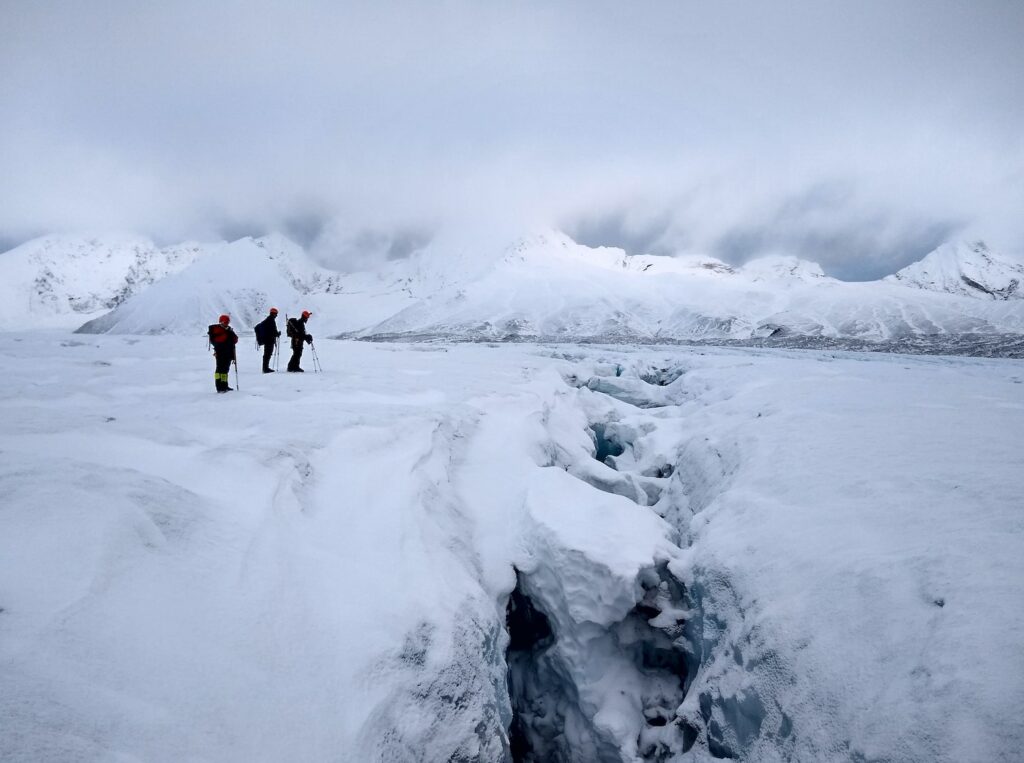
Unpredictable avalanches and bottomless crevasses
Snow conditions change rapidly in the alpine, creating unsafe snow conditions and risks of avalanches.
Crevasses are cracks or openings that form in glaciated terrain, many of which can be hidden and whose depths are unknown. The location of crevasses changes with the seasons.
Dehydration and malnourishment
Climbing in the alpine requires long days. You have to get up early, often before sunrise, and be prepared to get home after dark. The longer you spend in the backcountry, the more you expose yourself to running out of food and water.
How to Start Alpine Climbing
Getting started with alone climbing is a logical progression for many climbers. However, the progression toward alpine climbing should be done methodically and with respect for what lay ahead. Here are some general recommendations.
Become a Proficient Trad Climber
Unlike sport climbing, bolts are practically non-existent on alpine climbs. Depending on the climb, certain sections up a pure rock face may have bolts or pitons, but alpine climbing is generally not sport climbing.
Therefore, we recommend being a proficient trad climber. Mastery of traditional rock gear is mandatory for most, if not all, alpine climbs. Placing protection, building anchors, and managing a variety of crack sizes are all invaluable skills for big routes.
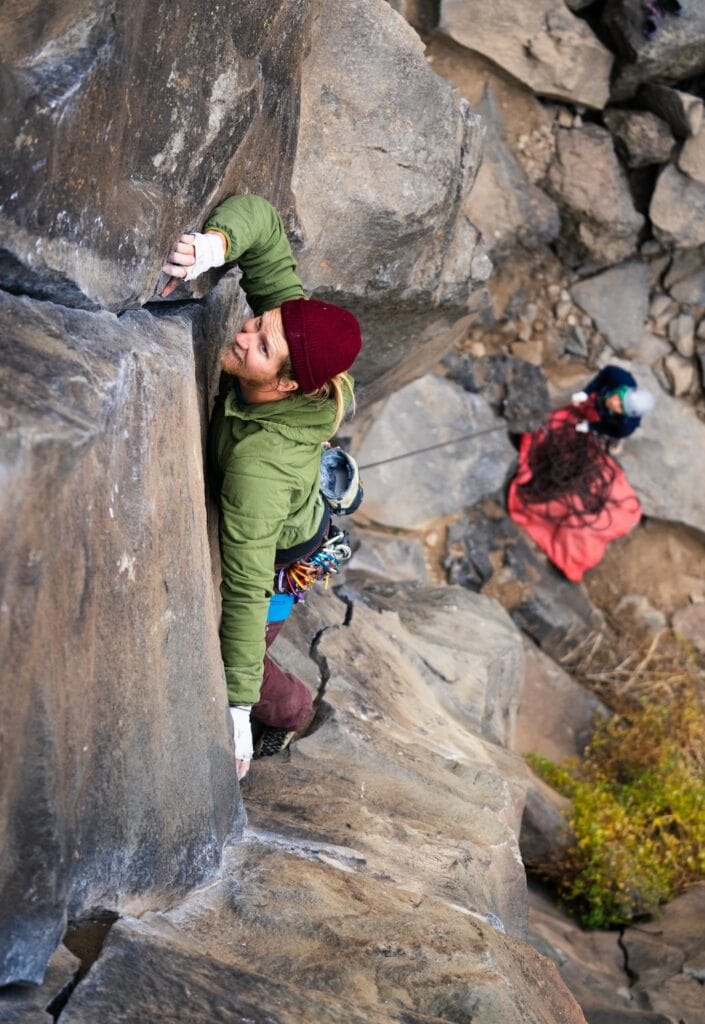
If the objective you want to climb involves ice or snow, the same can be said for the discipline of ice climbing. Placing protection, building anchors, making v-threads, and managing equipment such as ice screws, pickets, and passive protection like nuts is indispensable if you want to reach the summit.
Start Small
When getting started, start small. Mother nature can be big and scary, so voluntarily easing yourself into her clutches is the best way to experience alpine climbing without suffering 100% of the time and coming home traumatized.
- Pick an objective with a short to medium-length approach, like Hallett Peak (6) in Rocky Mountain National Park.
- Try a route with difficulty well within your physical ability and skill set, even if it means you climb 5.6, like the East Ridge up Disappointment Peak (7) in the Tetons of Wyoming.
Spend Time at Altitude
Your first time at altitude should not be on the approach on the way to your first alpine objective. It’s best to spend time at altitude beforehand so you test how your body will react with less oxygen at high elevations.
Have A Safety Plan
Climbing in the alpine is a committing serious endeavor. Depending on the objective, you can be out of cell phone reception and miles away from the trailhead, and even farther from emergency medical help. You cannot simply leave the mountains and see a doctor if something goes wrong.
For that reason, creating a safety plan for big climbs is a good idea. Your safety plan will vary based on the intended objective, but in general, it should include information to mitigate risk before and during the climb, as well as a specific emergency response plan if something goes south.
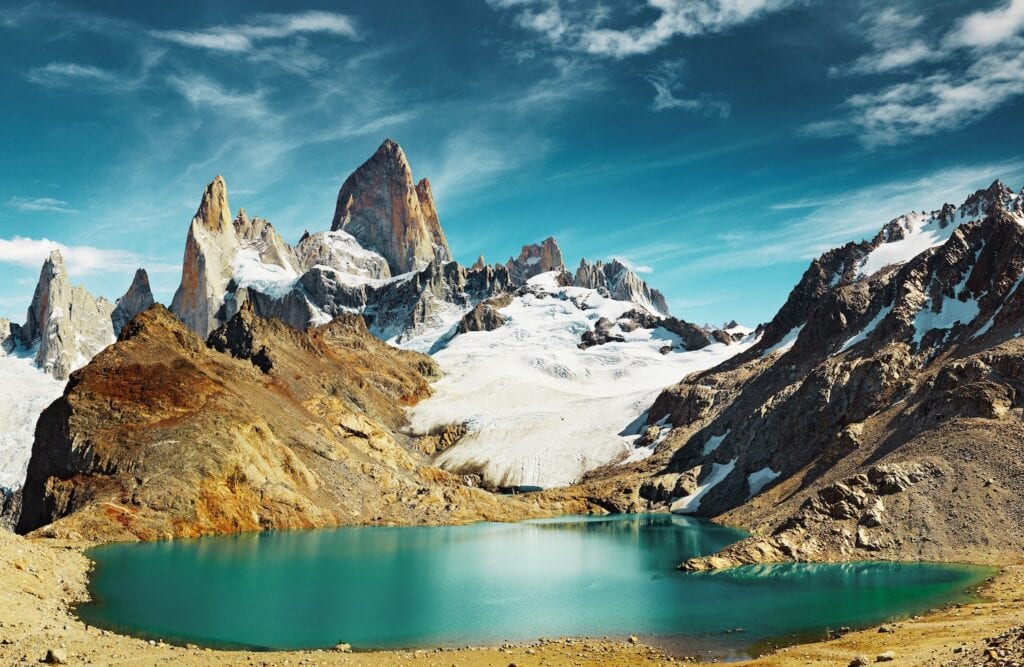
Your detailed plan may include:
- Details of your trip, like your destination and proposed return time, should be left in the front country with a trusted family member or friend who can contact the authorities if necessary.
- A predicted weather forecast and a plan to receive forecast updates for extended trips.
- Proper amounts of food, water, camping equipment (if necessary) for the length of the trip, as well as appropriate clothing for the predicted forecast.
- Emergency contact information for local search and rescue and law enforcement agencies.
- A cellphone (fully charged), a satellite communication device (8), auxiliary batteries, topographic map, and compass for analog navigation.
- Awareness of where the nearest cellphone reception can be found.
- Understanding of the safest and fastest evacuation routes.
Apart from your safety plan, it’s also a good idea to have mastery over basic self-rescue techniques. Depending on the terrain, rock, and ice, self-rescue techniques may be required. We also recommend bringing a well-stocked first aid kit and becoming trained in wilderness first aid (9).
Hire A Guide
Committing to a big route in the alpine can be an intimidating endeavor. There is a lot to learn beforehand and even more to consider throughout the climb. Hiring a climbing guide is a good way to learn new skills, and enter the alpine with a trained professional who understands the hazards of the route, has experience on a glacier, knows how to navigate the rock face, and can develop a robust safety plan.
Recommended Gear For Alpine Climbing
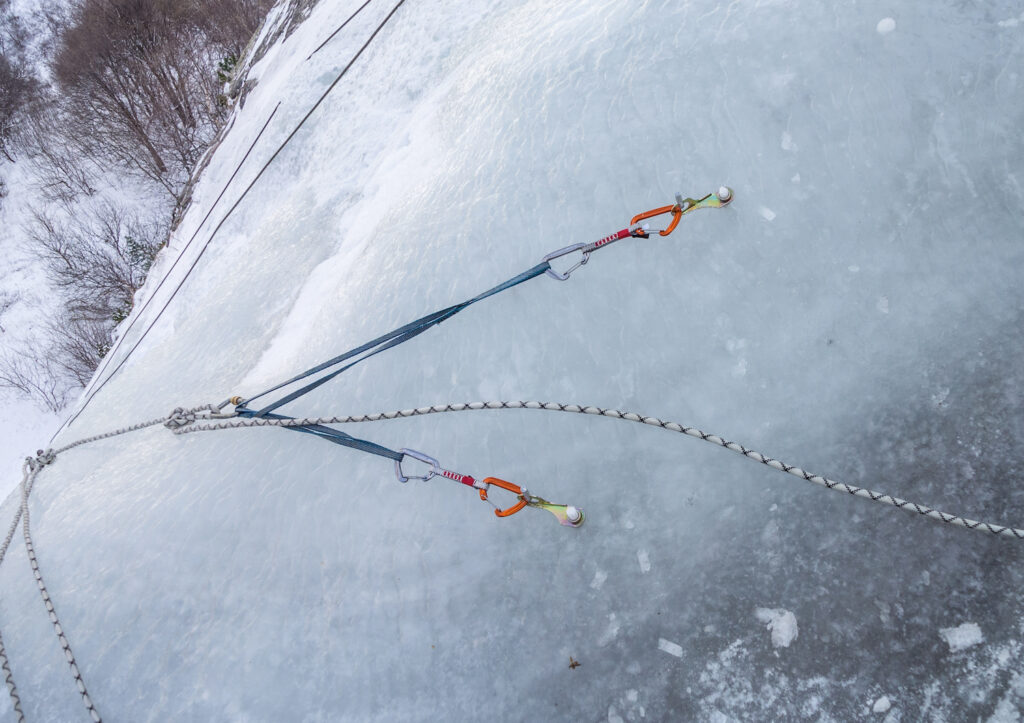
If you and considering going climbing in the alpine, chances are you are already relatively equipped with basic climbing equipment. However, to get into the sport of mountaineering, you may need extra equipment to be properly equipped.
- Helmet. The risk from overhead hazards like rock and ice, as well as head injuries from falling, can be mitigated with a modern climbing helmet.
- A climbing or glacier harness.
- Shoes that match the terrain. Approach shoes, rock, and mountaineering boots may all be necessary.
- Climbing ropes. Double ropes may be required depending on the objective and intended descent plan.
- A robust climbing rack to suit the objective and to remain well-protected. Cams, nuts, slings, more cams, a nut tool, quickdraws, pitons, and hexes may be required.
- Belay devices. It’s best to bring a belay device that can also be used for rappelling.
- Ice axes and crampons, ice screws, and pickets for snow.
- Specialized self-rescue equipment for hauling on the route or performing crevasse rescues on the glacier.
- Sling material for building bomber anchors and improvised bail anchors.
- Headlamp for when you plan to climb in the dark or get benighted.
- A fully stocked first aid kit, including over-the-counter medications.
- Adequate food, water, and proper clothing for the type of trip.
- A backpack to carry everything to the route. Plus, some climbers also bring a secondary, smaller pack for on-route.
Ultimately, our list is only helpful for brainstorming. What you bring will depend on your objective and how you like to pack.
Have fun! Be safe, and check your knots!
References
Upper Chaos Canyon
Mountain Project (retrieved on 02/10/2023)
https://www.mountainproject.com/area/106286424/upper-chaos-canyon
Cerro Torre
Wikipedia (retrieved on 02/10/2023)
https://en.wikipedia.org/wiki/Cerro_Torre
The Diamond
Mountain Project (retrieved on 02/10/2023)
https://www.mountainproject.com/area/105744826/the-diamond
Golden Age of Alpinism
Wikipedia (retrieved on 02/10/2023)
https://en.wikipedia.org/wiki/Golden_age_of_alpinism
Sean Villanueva O’Driscoll Completes The Fitz Traverse Solo
Bennett Slavsky
Climbing Magazine (Feb 202)
https://www.climbing.com/news/sean-villanueva-odriscoll-completes-the-fitz-traverse-solo/
Hallett Peak
Mountain Project (retrieved on 02/10/2023)
https://www.mountainproject.com/area/105744829/hallett-peak
East Ridge
Mountain Project (retrieved on 02/10/2023)
https://www.mountainproject.com/route/105984852/east-ridge
INREACH Satellite Communication
https://discover.garmin.com/en-US/inreach/personal/
Wilderness First Responder with NOLS and REI
https://www.rei.com/events/70596/wilderness-first-responder-with-nols-and-rei
